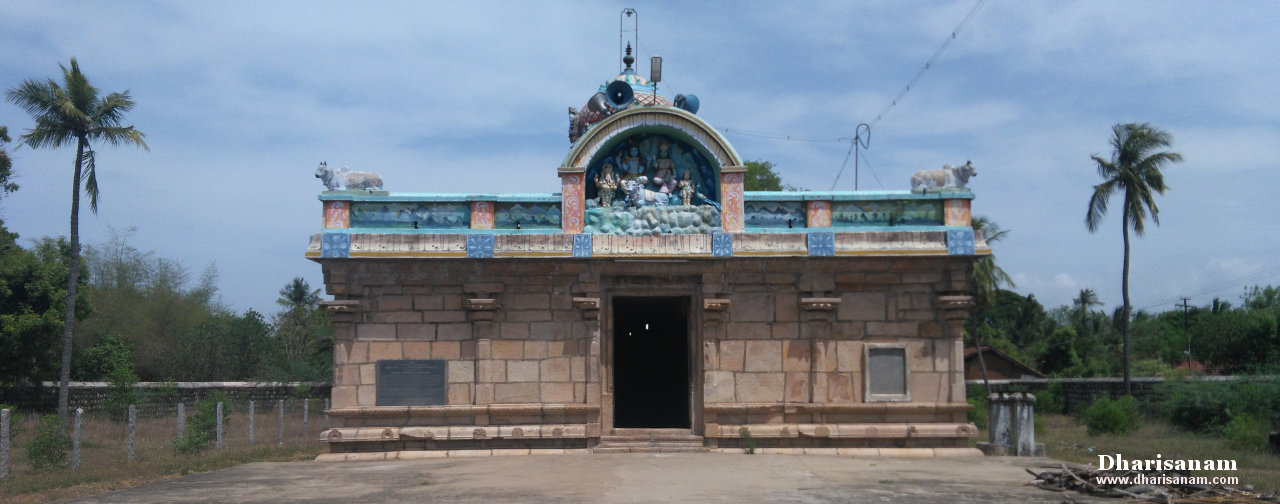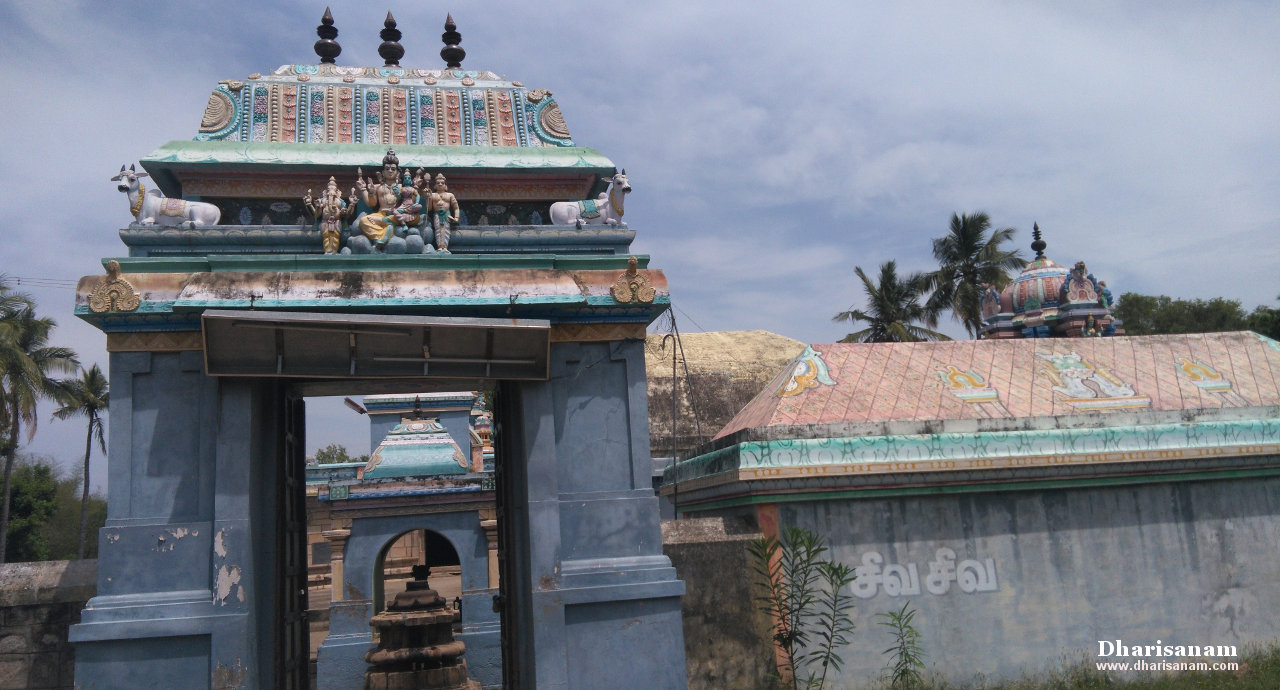Visited on: 12th June, 2018.
Location
Ramanadeecharam (Thiru Kannapuram) is situated at a distance of about 12 kms from Nannilam. It is about 2.5 kms away from Thiru Pukalur bus stop and 3 kms away from Thiru Chenkattangudi.
Other Devara Paadal Petra Shiva Sthalams near this place are –
Thirupugalur, Thirupugalur Vardhamaneecharam, Thiru Chenkattangudi, Nannilam, Thirumarugal, Thiru Sathamangai, Thiru Kondeecharam, Thiru Panaiyur and Thiru Payatrur.
General Information
| Moolavar | Sri Ramanatha Swamy, Sri Ramanadeeswarar |
| Ambal | Sri Sarivar Kuzhali Ammai, Sri Choolikaambal |
| Theertham (Holy water) | Surya Pushkarani, Rama Theertham |
| Sthala Vriksham (Sacred Tree) | Sanbakam tree |
| Pathigam (Hymn) rendered by | Saint Thirugnanasambanthar-1 |
- This is one of the 276 Devara Paadal Petra Shiva Sthalams and 77th Shiva Sthalam on the Southern bank of the river Cauveri in Chozha Nadu (Thenkarai).
- Lord Shiva in this temple is a Swayambumurthi (self-manifested).
- This east facing temple has two corridors and its main tower is not tiered. In place of the Gopuram, there is a beautiful sculpture depicting Lord Shiva and Goddess Parvathy.
- There is no flag post (Dwajasthambam) here.
- The last consecration ceremony (Maha Kumbabishekam) took place on 11.11.2012.
History of the Temple
There are five stone inscriptions in this temple. According to these inscriptions, King Kulothunga Chola renovated this temple and gifted lands in the village called “Sivapatha Sekara Mangalam” for the maintenance of this temple. In these inscriptions, the lord of this temple is referred to as “Sri Rama Nandeechara Mudaiyar”.
The historical name of this place is Rama Nandheecharam which was later changed to Ramanadeecharam and is now known as Thiru Kannapuram.
This is one of the auspicious temples that Lord Ram visited on his way back to Ayothya.
This temple is under the administrative control of (Thiruppukalur) Velakurichi Adheenam and the HR & CE.



Legend
As per legend, Lord Ram worshiped Lord Shiva at many temples when he was on his way back to Ayodhya. He did so because he wanted to seek relief from the sins that he had accrued during the course of the war with Ravana in Sri Lanka.
This is one of the many places where Lord Ram worshiped Lord Shiva. It is believed that Nandi was unaware of Lord Ram’s identity and hence did not allow him to touch the lord. Goddess Parvathi controlled Nandhi by holding him with her arm and allowed Ram to worship the lord. Hence this place gets the name “Rama Nandhi Eswaram” which later changed to Rama Nadeecharam. In the procession idol of Sri Somaskanda, Goddess Parvathi is holding Nandhi in her hand. However, now this idol is kept in Thirupugalur temple for safety reasons.
Another legend associated with this temple is that Sage Agasthiyar visited this place and worshiped the lord. It is believed that the sage installed the idol of Bairavar here.
Another legend associated with this temple is that a local king prayed to Lord Shiva for child boon and performed a yagna. Through his divine voice, the lord informed the king that he would be blessed with a girl child soon and this child would be an incarnation of Goddess Parvathy herself. At a later date, when the king went to the forest for hunting, he found four young girls under a tree. He brought them to his palace and raised them as his own daughters. When they attained the marriageable age, the king prayed to Lord Shiva and requested the lord to marry them. It is believed that the lord married them. Hence, there are four temples nearby each housing one of the goddesses – Sri Sarivar Kuzhali in this temple, Sri Vaaitha Thirukuzhal Nayaki in Thiruchengattangudi, Sri Karundhar Kuzhali in Thirupugalur and Sri Vanduvaar Kuzhali in Thirumarugal.
It is believed that these four Goddesses once helped a pregnant woman deliver her child. Hence, these goddesses are referred by the common name “Sri Choolikambal” (“Chool” or “Karu” means pregnancy in Tamil). It is believed that when the goddesses returned to the temple after this incident, they stayed at a little distance away from the lord’s shrine. This is symbolically represented in all the four temples as the goddess’s shrine is located separate from the lord’s shrine.
Deities in the temple
Other than the shrines of Lord Shiva and Goddess Parvathy, shrines and idols of Vinayakar, Murugan with his consorts, Mahalakshmi, Chandikeswarar, Navagraham, Bairavar, Shivalingam worshiped by Sage Durvasar, a Shivalingam, Agasthiyar, Thirunavukkarasar, Thirugnanasambanthar, Kamadhenu and Suryan can be seen in the corridors.
In the “koshtam” (place surrounding the sanctum sanctorum), idols of Dakshinamurthy, Lingothbavar, Brahma and Durgai can be seen.








Salient Features
The idol of main deity is a tall Swayambu lingam on a big base “(Avudayar”).
It is worth noting that when Aarthy is performed, its reflection is visible on the main deity.
Behind the sanctum sanctorum, on either sides of Lord Lingothbavar, there are idols of Lord Mahavishnu and Lord Brahma in a worshipping posture. Devotees can enjoy the darshan of all the three lords (Trimurthys) – Brahma, Vishnu and Shiva. This is considered to be very auspicious.
In this temple Goddess Parvathy is also praised as Sri Karu Katha Ambigai. There are a couple of paintings in the front hall of Goddess Parvathy’s shrine. One of them depicts Sage Agasthiyar worshiping Lord Shiva and in the other painting he is shown worshiping Lord Bairavar.

Greatness of this temple
Pregnant women worship Goddess Parvathy of this temple for safe childbirth.
This temple is famous for people having the birth star “Punarpoosa” as this is the birth star of Lord Ram.
Important Festivals
Some of the important festivals celebrated in this temple are –
Vinayakar Chaturthi in the Tamil month of Aavani (Aug-Sept),
Annabishekam in the Tamil month of Aippasi (Oct–Nov),
Thiru Karthikai in the Tamil month of Karthikai (Nov-Dec),
Makara Sankranthi in the Tamil month of Thai (Jan-Feb) and
Shivrathri in the Tamil month of Masi (Feb-Mar).
Pradosham is also observed regularly.
Temple Timings
From 08:30 AM to 12:00 Noon and from 05:00 PM to 08:00 PM.
Temple Address
Sri Ramanatha Swamy Temple,
Ramanadeecharam (Thiru Kannapuram),
Thirumarugl Taluk,
Nagapattinam District,
Tamil Nadu – 609 704.
Tele: +91 – 94431 13025, 4366–292300, 4366-291257.






Pathigam (Hymn) with English transliteration and Tamil meaning.
Saint Thirugnanasambanthar visited this temple and sang this Pathigam.
Devotees visiting this temple should make it a practice to recite this Pathigam.
Pathigam No.1.115
சங்கொளிர் முன்கையர் தம்மிடையே
அங்கிடு பலிகொளு மவன்கோபப்
பொங்கர வாடலோன் புவனியோங்க
எங்குமன் இராமன தீச்சுரமே.
“Saṅkoḷir muṉkaiyar tham'miṭaiyē
aṅkiṭu palikoḷu mavaṉkōpap
poṅkara vāṭalōṉ puvaṉiyōṅka
eṅkumaṉ irāmaṉa thīchchuramē”.
சங்கு வளையல்கள் அணிந்த முன்கைகளை உடைய முனி பன்னியர் வாழும் வீதிகளிடையே சென்று அங்கு அவர்கள் இடும் பலியை மகிழ்வோடு கொள்பவனும், சினம் பொங்கும் அரவைப் பிடித்து ஆட்டுபவனும், உலக மக்கள் உயர்வுபெற எங்கும் நிறைந்திருப்பவனுமாகிய சிவபிரானது தலம் இராமனதீச்சரம்.
சந்தநன் மலரணி தாழ்சடையன்
தந்தம தத்தவன் தாதையோதான்
அந்தமில் பாடலோன் அழகன்நல்ல
எந்தவன் இராமன தீச்சுரமே.
“Santhanaṉ malaraṇi thāzhsaṭaiyaṉ
thanthama thaththavaṉ thāthaiyōthāṉ
anthamil pāṭalōṉ azhakaṉnalla
enthavaṉ irāmaṉa thīchchuramē”.
அழகிய நல்ல மலர்களை அணிந்து தாழ்ந்து தொங்கும் சடையினை உடையவனும், தந்தத்தையும் மதத்தையும் உடைய விநாயகப் பெருமானின் தந்தையும், முடிவற்ற இசைப்பாடல்களைப் பாடுபவனும், அழகனும், எங்கள் தவப்பேறாய் விளங்கும் நல்லவனுமாய சிவபிரானது தலம், இராமனதீச்சரம்.
தழைமயி லேறவன் தாதையோதான்
மழைபொதி சடையவன் மன்னுகாதிற்
குழையது விலங்கிய கோலமார்பின்
இழையவன் இராமன தீச்சுரமே.
“Thazhaimayi lēṟavaṉ thāthaiyōthāṉ
mazhaipothi saṭaiyavaṉ maṉṉukāthiṟ
kuzhaiyathu vilaṅkiya kōlamārpiṉ
izhaiyavaṉ irāmaṉa thīchchuramē”.
தழைத்த பீலியோடு கூடிய மயில்மீது ஏறிவரும் முருகனது தந்தையும். உலகிற்கு நீர்வளந்தரும் கங்கை பாயும் சடையினை உடையவனும், காதில் நிலைபெற்று விளங்கும் குழையை அணிந்தவனும், அழகிய மார்பில் குறுக்காக முப்புரிநூல் அணிந்தவனுமாகிய சிவபிரானது தலம் இராமனதீச்சரம்.
சத்தியு ளாதியோர் தையல்பங்கன்
முத்திய தாகிய மூர்த்தியோதான்
அத்திய கையினில் அழகுசூலம்
வைத்தவன் இராமன தீச்சுரமே.
“Saththiyu ḷāthiyōr thaiyalpaṅkaṉ
muththiya thākiya mūrththiyōthāṉ
aththiya kaiyiṉil azhakuchūlam
vaiththavaṉ irāmaṉa thīchchuramē”.
சத்திகளில் முதல்வியாக விளங்கும் உமையம்மையை ஒரு பாகமாகக் கொண்டவனும், உயிர்கட்கு முத்திப்பேறாக விளங்கும் கடவுளும், தீயேந்திய கையில் அழகிய சூலத்தைத் தாங்கியவனுமாகிய சிவபிரானது தலம் இராமனதீச்சரம்.
தாழ்ந்த குழற்சடை முடியதன்மேல்
தோய்ந்த இளம்பிறை துளங்குசென்னிப்
பாய்ந்தகங் கையொடு படவரவம்
ஏய்ந்தவன் இராமன தீச்சுரமே.
“Thāzhntha kuzhaṟsaṭai muṭiyathaṉmēl
thōyntha iḷampiṟai thuḷaṅkuseṉṉip
pāynthagaṅ gaiyoṭu paṭavaravam
ēynthavaṉ irāmaṉa thīchchuramē”.
தலையில், தாழ்ந்த கூந்தலால் இயன்ற சடை முடியின்மேல், அழகு தோய்ந்த இளம்பிறை, பாய்ந்துவரும் கங்கை, படம் பொருந்திய அரவம் ஆகியவற்றைச் சூடிய சிவபிரானது தலம் இராமனதீச்சரம்.
சரிகுழல் இலங்கிய தையல்காணும்
பெரியவன் காளிதன் பெரியகூத்தை
அரியவன் ஆடலோன் அங்கையேந்தும்
எரியவன் இராமன தீச்சுரமே.
“Sarikuzhal ilaṅkiya thaiyalkāṇum
periyavaṉ kāḷithaṉ periyakūththai
ariyavaṉ āṭalōṉ aṅkaiyēnthum
eriyavaṉ irāmaṉa thīchchuramē”.
பிடரியின்மேல் விளங்கும் சுருண்ட கூந்தலினளாகிய உமையம்மை அருகிலிருந்து காணும் பெரியவனும், காளியின் பெரிய கூத்தோடு போட்டியிட்டு அவளால் அறிதற்கு அரியவனாய், நடனமாடுபவனும், அழகிய கையில் எரி ஏந்தி விளங்குபவனுமாகிய சிவபிரானது தலம் இராமனதீச்சரம்.
மாறிலா மாதொரு பங்கன்மேனி
நீறது ஆடலோன் நீள்சடைமேல்
ஆறது சூடுவான் அழகன்விடை
ஏறவன் இராமன தீச்சுரமே.
“Māṟilā māthoru paṅkaṉmēṉi
nīṟathu āṭalōṉ nīḷsaṭaimēl
āṟathu chūṭuvāṉ azhakaṉviṭai
ēṟavaṉ irāmaṉa thīchchuramē”.
தனக்கு ஒப்பாரில்லாத அழகிய உமையம்மையை ஒரு பாகமாகக் கொண்டவனும், திருமேனியில் திருநீற்றை அணிந்தவனும், நீண்ட சடைமுடியின்மேல் கங்கையைச் சூடியவனும் அழகனும், விடையின்மேல் ஏறி வருபவனுமாகிய சிவபிரானது தலம் இராமனதீச்சரம்.
தடவரை அரக்கனைத் தலைநெரித்தோன்
படவர வாட்டிய படர்சடையன்
நடமது வாடலான் நான்மறைக்கும்
இடமவன் இராமன தீச்சுரமே.
“Thaṭavarai arakkaṉaith thalaineriththōṉ
paṭavara vāṭṭiya paṭarsaṭaiyaṉ
naṭamathu vāṭalāṉ nāṉmaṟaikkum
iṭamavaṉ irāmaṉa thīchchuramē”.
பெரிய கயிலை மலையால் இராவணனின் தலையை நெரித்தவனும், படம் பொருந்திய பாம்பை ஆட்டி மகிழ்பவனும், விரிந்த சடைமுடியை உடையவனும், நடனம் புரிபவனும், நான்கு வேதங்கட்கும் இடமாக விளங்குபவனும் ஆகிய சிவபிரானது தலம் இராமனதீச்சரம்.
தனமணி தையல்தன் பாகன்றன்னை
அனமணி அயன்அணி முடியுங்காணான்
பனமணி அரவரி பாதங்காணான்
இனமணி இராமன தீச்சுரமே.
“Thaṉamaṇi thaiyalthaṉ pākaṉtṟaṉṉai
aṉamaṇi ayaṉaṇi muṭiyuṅkāṇāṉ
paṉamaṇi aravari pāthaṅkāṇāṉ
iṉamaṇi irāmaṉa thīchchuramē”.
அழகிய தனபாரங்களையுடைய உமையம்மையின் கேள்வனும், அன்னமாகத் தன்னை மாற்றிக் கொண்டு, அழகிய முடியைக் காணாது திரும்பிய நான்முகன், திருவடியைக் காணாத, படங்களில் மணிகளையுடைய ஆதிசேடனாகிய அணையில் துயிலும் திருமால் ஆகியோர் வணங்க அருள் புரிந்தவனுமாகிய சிவபிரானது தலம் பல்வகையான மணிக்குவைகளையுடைய இராமனதீச்சரம் ஆகும்.
தறிபோலாஞ் சமணர்சாக் கியர்சொற்கொளேல்
அறிவோரால் நாமம் அறிந்துரைமின்
மறிகையோன் தன்முடி மணியார்கங்கை
எறிபவன் இராமன தீச்சுரமே.
“Thaṟipōlāñ samaṇarchāk kiyarchoṟkoḷēl
aṟivōrāl nāmam aṟinthuraimiṉ
maṟikaiyōṉ thaṉmuṭi maṇiyārgaṅgai
eṟipavaṉ irāmaṉa thīchchuramē”.
மரத்தால் இயன்ற தடிபோன்ற அறிவற்ற சமண புத்தருடைய சொற்களைக் கேளாதீர். மெய்ஞ்ஞானியர்கள் வாயினால் இறைவன் திருப்பெயரை அறிந்து சொல்வீர்களாக. அப்பெருமான் மான் இளங்கன்றை ஏந்திய கையனாய்த் தனது முடியில், மணிகளோடு கூடிய கங்கை நதி அலை, மோதுபவனாய், இராமனதீச்சரத்தில் எழுந்தருளியுள்ளான். சென்று வழிபடுக.
(*) இப்பதிகத்தில் 11-ம் செய்யுள் சிதைந்து போயிற்று.
(*) Ippathikaththil 11-m seyyuḷ sithainthu pōyitṟu.







